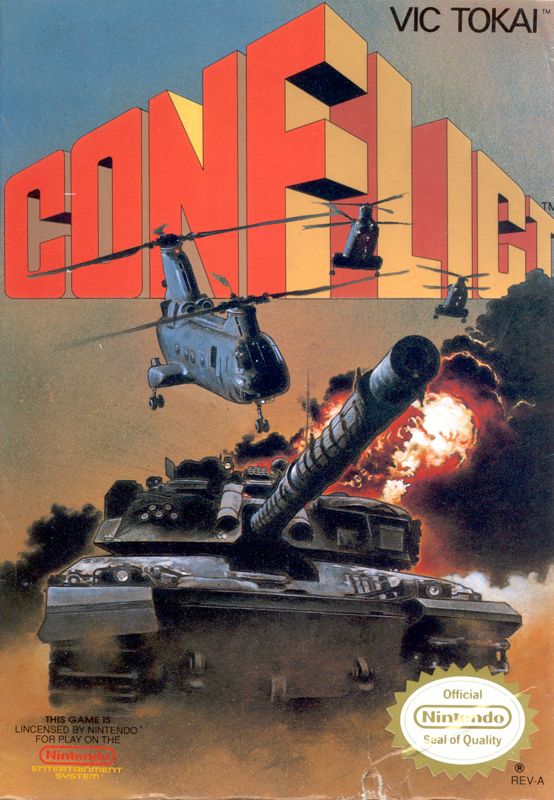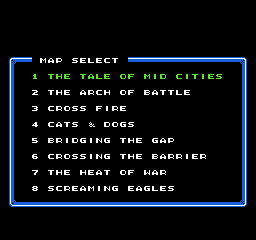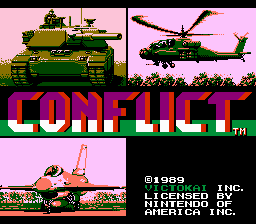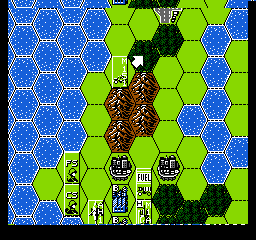Retro Replay Review
Gameplay
Conflict’s core gameplay revolves around a turn-based, hex-grid wargame system that feels surprisingly deep for an NES title. Players maneuver NATO-modeled Blue forces or Warsaw Pact–modeled Red forces across sprawling hex maps, seizing towns and securing strategic positions. Each move on the operational layer demands foresight: which units to press forward, where to establish defensive lines, and how to allocate your limited resources.
When two opposing units engage, the action shifts seamlessly into a tactical combat module. Here, you can choose to issue direct orders—position your infantry, direct your tanks, and orchestrate combined-arms maneuvers—or hand control over to the AI’s “auto” mode. This duality lets casual players breeze through the fights while hardcore tacticians savor the satisfaction of outthinking their opponent on a smaller scale.
Progression is tied to “fame” points, earned by capturing towns and winning skirmishes. These points can be exchanged between scenarios for upgrades and reinforcements, adding a rewarding meta-layer of customization. Whether you’re bolstering your tank battalions with improved firepower or reinforcing your infantry with anti-tank weaponry, the strategic choices you make have lasting consequences on the battlefield.
Graphics
On the visual front, Conflict offers clean, functional sprites and tilework that communicate unit types and terrain clearly. Each hex features distinctive coloring for plains, forests, and urban centers, ensuring there’s no ambiguity in movement costs or line-of-sight considerations. Though limited by the NES palette, the designers manage to imbue each scenario with its own aesthetic flair.
During tactical encounters, splash graphics announce critical events—explosions, successful tank shots, and unit destruction—with bold, pixel-art flair. It may not rival arcade shooters of the era, but these animations provide satisfying feedback, reinforcing the drama of each firefight. Text messages further detail combat outcomes, displaying damage dealt and morale shifts so you’re never in the dark about why a unit stood its ground—or broke and ran.
Menu screens and unit portraits are minimalist but serviceable. Iconography for supply levels, movement points, and attack ranges is intuitive, minimizing the learning curve for newcomers to hex-based wargaming. Overall, Conflict’s visuals strike a pragmatic balance: they’re never dazzling but always clear, keeping the player’s focus where it belongs—on tactical decision-making.
Story
Although Conflict doesn’t retell historical battles, it weaves a compelling “what-if” Cold War narrative across its 16 scenarios. Each map represents an imaginary engagement between East and West, from dense forests of Central Europe to urban clashes in forgotten border towns. The lack of real-world geography actually works in the game’s favor, freeing it from strict historical reenactment and letting you focus on strategic variety.
The progression through the alphabetic passwords—one letter awarded for each victory in the first 15 scenarios—adds an overarching goal: unlock the final, climactic confrontation by mastering all preceding battles. This design choice injects a sense of continuity and purpose, as you steadily piece together the six-letter code needed to face the ultimate showdown.
Dialogue is sparse, limited to briefing screens and mission debriefs, but it’s enough to set the stakes and remind you of the geopolitical backdrop. The binary opposition of Blue vs. Red forces may be simple, but by the end of the campaign, you’ll feel like a seasoned commander whose decisions shaped the course of an alternate Cold War conflict.
Overall Experience
Conflict may lack the polish of later console war games, but its combination of strategic depth and tactical flexibility remains impressive. Whether you’re a solo player experimenting with AI-controlled opponents or teaming up with a friend in two-player mode, the game’s systems hold up remarkably well. Matches can be long and challenging, rewarding patience and careful planning.
The fame-points economy and hardware upgrades introduce an addictive metagame loop. Every victory feels meaningful, as you watch your forces grow stronger and more capable. This sense of progression drives you forward, pushing you to refine your strategies and tackle higher-difficulty scenarios with renewed confidence.
In the landscape of NES titles, Conflict stands out as a thoughtful, engrossing wargame that balances accessibility with complexity. Its clear graphics, solid AI options, and imaginative Cold War premise make it a must-try for fans of turn-based strategy. If you’re seeking a title that challenges your tactical acumen and keeps you coming back for “just one more scenario,” Conflict delivers on all fronts.
 Retro Replay Retro Replay gaming reviews, news, emulation, geek stuff and more!
Retro Replay Retro Replay gaming reviews, news, emulation, geek stuff and more!









Reviews
There are no reviews yet.